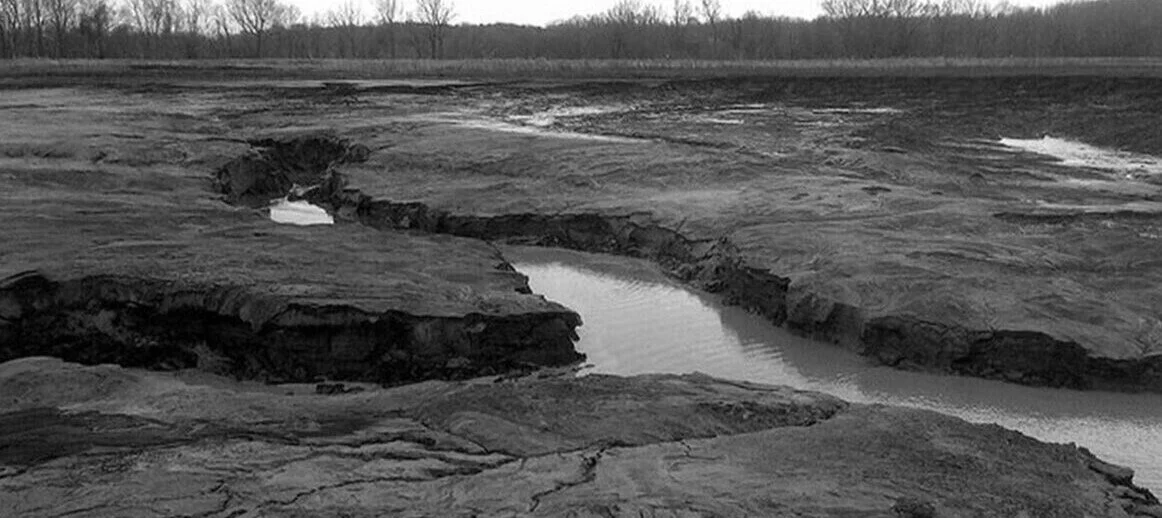Coal Ash at a Glance
Coal ash, also referred to as coal combustion residuals or CCRs, is produced primarily from the burning of coal in coal-fired power plants or industrial boilers such as paper mills or steel mills. Coal ash includes a number of by-products produced from burning coal, including:
Fly Ash, a very fine, powdery material composed mostly of silica made from the burning of finely ground coal in a boiler.
Bottom Ash, a coarse and angular ash particle that is too large to be carried up into the smoke stacks so it forms in the bottom of the coal furnace.
Boiler Slag, molten bottom ash from slag tap and cyclone type furnaces that turns into pellets that have a smooth glassy appearance after it is cooled with water.
Flue Gas Desulfurization Material, a material leftover from the process of reducing sulfur dioxide emissions from a coal-fired boiler that can be a wet sludge consisting of calcium sulfite or calcium sulfate or a dry powered material that is a mixture of sulfites and sulfates.
Coal ash contains heavy metals, which when coal ash is placed into unlined landfills or ash ponds, can leach into the water table thereby, contaminating large swaths of drinking water within our communities. Before the advent of GCS, the coal utilities industry didn’t have a comprehensive solution for the management of coal ash. The Environmental Protection Agency reports that coal ash has historically been “beneficially” re-used or “recycled” to varying degrees such as constructing the top layer on unpaved roads; an additive to concrete, filling for abandoned mines and gypsum wallboard. Of great concern, however, is that when the traditional forms of “beneficial re-use” of coal ash are excluded, only 20% of coal ash is defined as recycled.
Another means that the industry has undertaken to manage coal ash, is the CAPPING of the coal ash in-place at the landfill or ash pond and then overlaying it with vegetation. In this approach, the coal ash landfill or ash pond is essentially buried for life with vegetation planted upon it thereafter. With this approach, the toxic heavy metals in the coal ash continue to leach into the water tables thereby, contaminating the drinking water for countless communities.
The industry has on other occasions, simply relocated their coal ash inventories from one state to another when public, environmental and political pressure arise. This approach is very costly and places added financial burdens on consumers of electric power since the cost is passed down to them in the form of rate increases. Besides the fact that this approach merely transfers the coal ash headache from one community to another, it is a very costly proposition the true cost of which, is usually shared with the electricity consumer in the form of approved electricity rate increases for the utility companies.
The capital and environmental cost of coal ash management in the United States have prohibited the full realization of the desired efficiencies within the coal electric power industry and the health of many of the regional populations over the years. With over 3 billion tons of coal ash in landfills and coal ash ponds across the U.S. and over 100 million tons of additional coal ash being generated each year, a capital and environmental crises loom across the country with respect to the safe/affordable storage and management of domestic coal ash inventories.
At an estimated landfill/coal ash pond remediation cost of about $100.00 per ton of coal ash and an estimate of more than 3 billion tons of coal ash currently in landfills/ponds, one can get a sense of the potential costs associated with the clean-up of these coal ash storage sites (https://www.wsj.com/articles/duke-energy-agrees-to-coal-ash-cleanup-settlement 11577994126?shareToken=stf092600b04724a8a8bb350f156f88ec6&reflink=article_email_share). While the utility industry has usually balked at the need to remediate their coal ash landfills or ash ponds beyond aged regulatory requirements, GCS partly attributes the industry’s disposition to the sheer cost of remediating coal ash sites. The nature of coal ash…its inability to dissipate or safely degrade, has motivated many environmentalists to call for the eventual remediation of all coal ash landfills and ash ponds.
While there has been a steady decline in the nation’s coal ash generation during the past ten years or so, said decline primarily applies to the coal power utility industry since the combustion of coal in other industries such as cement manufacturing, fertilizer plants, paper/pulp mills and steel mills have remained vibrant. Of equal concern with respect to higher coal ash inventories, is the nation’s emerging endeavors into the mining of rare earth minerals from coal/coal ash, which will undoubtedly generate additional coal ash inventories. Some notable U.S coal ash incidents include the following:
The 2008 Kingston Power Plant Coal Ash Spill (Appalachian Voices): https://appvoices.org/coalash/disasters/
Legacy Coal Ash Ponds (by Earth Justice): https://earthjustice.org/blog/2020-june/legacy-coal-ash-ponds-are-a-disaster-in-waiting-is-there-one-near-you
Dominion Virginia Power Possum Point, Virginia Ash Pond Cleanup: https://www.washingtonpost.com/local/virginia-politics/coal-ash-clean-up-bill-wins-bipartisan-backing-in-virginia/2019/01/24/99c2a798-1ff4-11e9-8e21-59a09ff1e2a1_story.html
Duke Energy, NC_$8B estimated coal ash cleanup cost: https://www.wxii12.com/article/duke-energy-new-coal-ash-settlement/35310922#
Little Blue Run Coal Ash Pond, Beaver County, PA: https://www.nationalgeographic.com/science/article/120809-little-blue-run-coal-ash-pond-to-close
A competing challenge for the nation, is the burgeoning desire of America to revitalize its manufacturing base while increasing employment. While several U.S-based companies have elected to re-locate their manufacturing operations from overseas back to domestic grounds, a greater number of American-founded manufacturing companies still have their operations residing beyond U.S. borders. And while it is the prerogative of any manufacturer to consider its bottom-line in determining its market of operations, the flight of U.S. manufacturing jobs has severely degraded and challenged the economic development of numerous U.S. communities.



